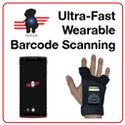
475: The Pivotal Role of Barcodes in Supply Chain Management with GS1
Barcodes are often underrated and underappreciated, but they play a pivotal role in product safety, efficiency, and movement within the global supply chain. In today’s episode of The New Warehouse Podcast, Reid Jackson, Vice President of Business Development at GS1 US, gives us the rundown on UPC barcodes and their role as passports for products in the supply chain. GS1 is renowned for setting the global standard in the supply chain, famously known for introducing the UPC barcode, an innovation that revolutionized retail and beyond. This episode delves into the foundational role of GS1 in standardization, its evolution alongside technology, and the future of supply chains.
GS1 and the UPC Barcode
The inception of GS1 is a story of necessity and innovation. Reid Jackson recounts, “We need the brands to have some type of identifier on them to speed up the checkout and to increase the accuracy.” This need led to creating the UPC barcode, marking a pivotal moment in retail and manufacturing. The initiative stemmed from the grocery industry’s demand for efficiency and accuracy at the checkout. GS1’s role extended beyond the barcode, emphasizing its technology-agnostic approach to solving industry-wide challenges.
Leveraging Barcodes in Supply Chain Management
The application of UPC codes and GS1 standards illustrates the vast impact on industries, exemplified by Reid’s Subway story. “Subway… would take product lettuce, tomato, meat, spreads, everything… take it into their inventory from tons of different suppliers, but they would inventory it all the same. When it came in, it was lettuce.” If there were ever a recall, they would have to return everything. “Now they’ve moved to GS1 standards,” Reid adds, allowing them to only send back impacted products in the case of a recall. This anecdote underscores the efficiency and safety GS1’s standards introduce to supply chain management, highlighting how specific product tracking can mitigate extensive product recall, ensure consumer safety, and reduce waste.
Advancing Technology with GS1 Standards
GS1’s engagement with emerging technologies signifies its continuous evolution. “We’re heavily involved with MIT and the Auburn RFID lab and constantly looking at these technologies and how they’re being implemented and used,” Reid shares. This forward-looking approach ensures GS1 standards remain relevant amidst advancements in warehousing, material handling, robotics, and beyond. GS1’s collaboration with technology institutions and industries fosters innovation while maintaining the utility and integrity of supply chain standards.
Key Takeaways on Barcodes in Supply Chain Management
- GS1 pioneered the UPC barcode, significantly enhancing retail and supply chain efficiency.
- Applying GS1 standards exemplifies the profound impact on product safety and recall management.
- GS1’s proactive involvement with technology and research institutions ensures its standards evolve with emerging supply chain innovations.
Listen to the episode and leave your thoughts in the comments.
Guest Information
For more information on GS1, click here.
To connect with Reid Jackson on LinkedIn, click here.
Check out the podcasts below for more information about barcodes in supply chain management.
474: AI for Warehousing with Powerhouse AI
re*





485: Addressing Excess Inventory With B-Stock Solutions » The New Warehouse
[…] 475: The Pivotal Role of Barcodes in Supply Chain Management with GS1 […]
504: Leveraging QR Codes to Transform Supply Chain Efficiency » The New Warehouse
[…] 475: The Pivotal Role of Barcodes in Supply Chain Management with GS1 […]